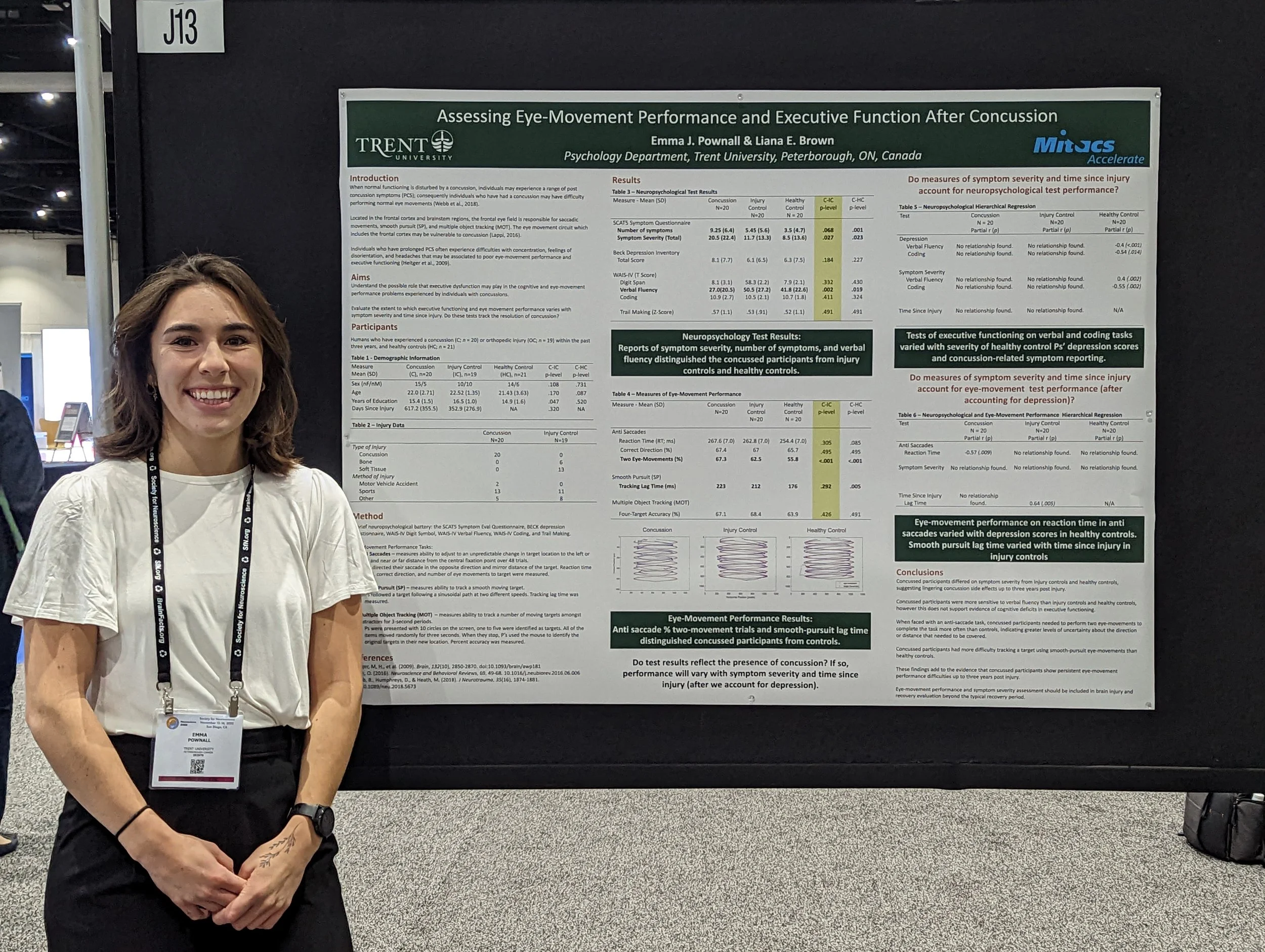The lab is equipped to study motor performance and learning.
We manipulate what, when, and how people see using customized displays.
We measure limb and eye movements using tracking devices and we can measure muscle activation using electromyography (EMG).
We manipulate and measure brain function using transcranial magnetic stimulation (TMS).
Current Research
How do athletes feel about returning to play after a concussion?
While there is a sizable literature on psychological preparedness for return to play after knee injuries, there have been surprisingly few studies documenting and characterizing athletes’ thoughts and emotions as they recover from and re-enter competition after concussion. Emma Pownall is leading a mixed-methods study on this topic, cosupervised by Fergal O’Hagan.
If you are an athlete who has recently returned to play after a concussion and would like to learn more about participating in this study, you can contact Emma by clicking this link.
Freezing in Parkinson’s Disease: A gait-only phenomenon?
Advancing Parkinson’s disease is characterized by freezing, most commonly observed as freezing of gait (FOG). With typical FOG, gait is interrupted by tremulous shuffling; people feel like their feet are glued to the floor. FOG is distressing; it substantially raises fear and risk of falling and it is a leading predictor of loss of independence.
But freezing seems to affect more than just gait. People with Parkinson’s (PwPD) show speech hesitation where ongoing speech unpredictably devolves into brief episodes of stuttering and freezing of upper limb (FOUL) has also been documented when PwPD are asked to perform repetitive finger-tapping movements that involve reversals and direction changes. There has been very little research reported that attempts to connect FOG, FOUL, and freezing of speech (FOS). Jennifer Stevenson’s study will look at whether certain visual spatial-frequency backgrounds induce or relieve FOG, and if they affect FOG and FOUL in a similar manner. Results consistent with these predictions would imply that there is a common source for freezing behaviours and that this common source is sensitive to stimulation by certain visual frequencies.
Another line of questioning considers whether freezing reflects impairment in executive functioning (EF). EF is a set of cognitive skills, linked to frontal-lobe function, that controls behavioural selection, sequencing, initiation, monitoring, and inhibition. PwPD who experience freezing perform more poorly on tests of EF. Interestingly, although walking is a skill that can be controlled largely at subcortical levels, walking demands cortical input at initiation, termination, and with heading changes, and it is at these points where FOG appears. This coincidence suggests that freezing may be explained by executive dysfunction. Leah Steinke’s study will employ the gap effect, an eye-movement effect that indexes executive function, to examine the relationship between EF and freezing.
If you are a person with Parkinson’s or an older healthy adult and would like to learn more about participating in these studies, you can contact Jennifer by clicking this link.
Do eye and limb movements document concussion recovery?
Even after scores on neuropsychological baseline tests return to normal, people recovering from concussion still lag behind healthy controls on eye- and hand-movement tests (Heitger et al., 2004; 2007; 2010). We have been re-examining this research in people who have experienced concussion up to three years prior to look at the relationships between motor performance, time since injury, and symptom severity. To control for the wide-ranging effects of being “sidelined” by injury, we compare people with concussion to people with an orthopedic injury.
If recovery of movement control is slower than recovery of cognition, return-to-play guidelines will need to be re-evaluated. Athletes who cannot adequately control their eye and limb movements are at heightened risk for a second (or Nth) concussion.
How do experts differ from people who are competent?
You’ve probably heard that to become an expert, you need to engage in deliberate practice for about 10000 hours. We’ve been testing the idea that experts are defined not only by consistency of practice, but also by the variety of subskills and scenarios to which they are exposed. This idea predicts that experts will be able to adapt to new (or old) situations using sensory cues more quickly than competents. We’ve been testing this prediction by asking both chefs and enthusiastic home cooks to perform knife skills in the lab.
Do near-hand targets trigger covert actions?
When people are asked to respond quickly to the presentation of a target, they respond faster if the target appears near, rather than far from, a hand! This difference in time is called the near-hand effect. Now we are considering the possibility that targets appearing near the hand trigger an unspecified but learned response in the brain regions controlling the nearby hand and that this extra activity leads to faster responding.
Why/How does stress affect movement performance?
Big meet? Championship game? Scout at practice today?
Got butterflies?
We know that physiological stress – increased breathing rate, heart rate, and sweating – can affect performance of even the most well-learned motor tasks. We don’t know why. What is the mechanism by which stress changes the neural signals needed for movement performance? We’ve started to address this question by examining if and how experimentally-induced stress changes performance of a very simple task – speeded visually-guided reaching.












